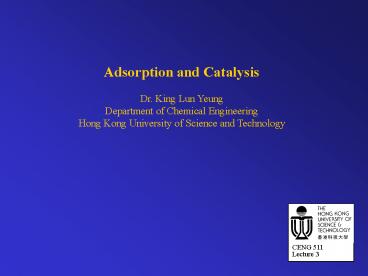Adsorption and Catalysis - PowerPoint PPT Presentation
1 / 76
Title:
Adsorption and Catalysis
Description:
Ink-bottle pore. Pore with shape of interstice between close-packed particles. Adsorbed layer ... Cracking or deforming of samples. Texture Data on Common Catalysts ... – PowerPoint PPT presentation
Number of Views:652
Avg rating:3.0/5.0
Title: Adsorption and Catalysis
1
Adsorption and Catalysis Dr. King Lun
Yeung Department of Chemical Engineering Hong
Kong University of Science and Technology
2
Physical Adsorption
- Texture and morphology
- specific surface area of catalyst
- pore size
- pore shape
- pore-size distribution (same size or various
sizes?) - pore volume
3
Pore Size and Shape
- Pore Diameter
- micropores (lt 2 nm)
- mesopores (2 50 nm)
- macropores (gt 50 nm)
- Pore Shape
- cylinder
- slit
- ink-bottle
- wedge
4
Pore Size and Shape
Pore Structure
5
Pore Size and Shape
Why is it important? it dictates the diffusion
process through the material.
6
Pore Size and Shape
Why is it important? directly affect the
selectivity of the catalytic reaction.
7
Pore Size and Shape
Measurement Techniques
8
N2 Physisorption
Adsorption and Desorption Isotherms
Desorption
Adsorption
9
N2 Physisorption
Adsorption and Desorption Isotherms
10
Isotherms
Type I Langmuir Adsorption Isotherm
- Assumptions
- homogeneous surface
- (all adsorption sites energetically identical)
- monolayer adsorption (so no multilayer
adsorption) - no interaction between adsorbed molecules
11
Isotherms
Type II
Multilayer adsorption (starting at B) Common for
pore-free materials
Type IV
Similar to II at low p Pore condensation at high p
12
Isotherms
Type III
Strong cohesion force between adsorbed molecules,
e.g. when water adsorbs on hydrophobic activated
carbon
Type IV
Similar to III at low p Pore condensation at high
p
13
Physisorption
Surface area measurement
14
Physisorption
Different Adsorbates Used in Physisorption Studies
15
N2 Physisorption
Adsorption and Desorption Isotherms
Langmuir Adsorption?
No strong adsorption at low p due to
condensation in micropores at higher p saturation
due to finite (micro)pore volume
16
BET Isotherm
17
BET Isotherm
18
BET Isotherm
Nonporous Silica and Alumina
- Low p/p0
- filling of micropores
- favoured adsorption at most reactive sites
(heterogeneity) - High p/p0
- capillary condensation
BET equation
Range 0.05 lt p/p0 lt 0.3 is used to determine SBET
19
Pore Size and Surface Area
20
Pore Size Distribution
Kelvin Equation
21
Pore Size Distribution
Kelvin Equation
22
Kelvin Equation
23
Kelvin Equation
Pore filling Model Cylindrical Pore Channel
24
Hysteresis Loop
Information on pore shape
25
Pore Size Distribution
t-Method
Note nad is experimental result t is calculated
from correlation t versus p
26
Kelvin Equation
t-Method
27
Kelvin Equation
Shape of t-plots
28
Kelvin Equation
Interpretation of t-Plot g-alumina
29
Kelvin Equation
Pore Size Distribution g-alumina
r t 2sV
30
Mercury Porosimetry
Pore Size Distribution
31
Mercury Porosimetry
Pore Size Distribution g-alumina
32
N2 Physisorption versus Hg Porosimetry
- Hg cannot penetrate small (micro)pores, N2 can
- Uncertainty of contact angle and surface tension
values - Cracking or deforming of samples
33
Texture Data on Common Catalysts
34
N2 Adsorption Isotherms Pore Volume
Distributions
N2 Adsorption Isotherms Pore Volume
Distributions
wide-pore silica
?-alumina
35
N2 Adsorption Isotherms Pore Volume
Distributions
?-alumina
activated carbon
36
N2 Adsorption Isotherms Pore Volume
Distributions
Raney Ni
ZSM-5
37
Hg Intrusion Curves Pore Volume Distributions
wide-pore silica
?-alumina
38
Hg Intrusion Curves Pore Volume Distributions
?-alumina
activated carbon
39
Hg Intrusion Curves Pore Volume Distributions
Raney Ni
ZSM-5
40
BET- t-plots
wide-pore silica
?-alumina
41
BET- t-plots
?-alumina
activated carbon
42
BET- t-plots
Raney Ni
ZSM-5
43
Chemisorption
Surface Characterization
- Specific surface area of phases
- Types of active sites
- Number of active sites
- Reactivity of active sites
- Stability of active sites
44
Chemisorption
Metal Dispersion
45
Adsorption Mode
46
Adsorption Stoichiometry
47
Particle Size and Dispersion
48
Supported Metal Particles
49
Number of Surface Atoms
50
Pulse Chemisorption
51
Pulse Chemisorption
On-line Thermoconductivity Detector
Monolayer capacity 0.06 mmol / g Pt
52
Step Chemisorption
On-line Mass Spectrometer
53
Temperature Programmed Desorption
Adsorption Site Differentiation NH3 desorption
from HZSM-5
54
Temperature Programmed Desorption
Adsorption Energetics
After ammonia saturation the sample is degassed
at 120 C for 60 minutes
Heating Rate of 5, 10, 15 and 20 C/min
55
Temperature Programmed Desorption
Adsorption Energetics
Beta heating rate K / min Tp maximum
desorption peak temperature Ed Desorption
energy Kj / mole A Arrhenius factor R
8.314451 J / mol K
56
Temperature Programmed Reduction
- characterisation of oxidic catalysts and other
reducible catalysts - qualitative information on oxidation state
- quantitative kinetic data
- optimisation of catalyst pretreatment
57
Temperature Programmed Reduction
Fe2O3
58
Temperature Programmed Reduction
Fe2O3
Dry H2/Ar
59
Temperature Programmed Reduction
Fe2O3
Wet H2/Ar (3 H2O)
60
Temperature Programmed Reduction
Fe2O3
61
Kinetic Models for Reduction
62
Infrared Spectroscopy
63
Infrared Spectroscopy
Reactor Cell
Transmittance
DRIFTS
64
Analysis of Catalyst Preparation
Surface Hydroxyl Groups
65
Analysis of Catalyst Preparation
66
IR Probe Molecule
Acidity Measurement
67
IR Probe Molecule
Acidity Measurement
68
Kelvin Equation
Pore Size Distribution
69
Kelvin Equation
Pore Size Distribution
70
In-Situ Reaction Study
TCE Photocatalytic Oxidation
71
In-Situ Reaction Study
PCO of Ethylene
72
In-Situ Reaction Study
PCO of 1,1-DCE
73
In-Situ Reaction Study
PCO of cis-1,2-DCE
74
In-Situ Reaction Study
PCO of trans-1,2-DCE
75
In-Situ Reaction Study
PCO of TCE
76
In-Situ Reaction Study
PCO of Tetrachloroethylene































